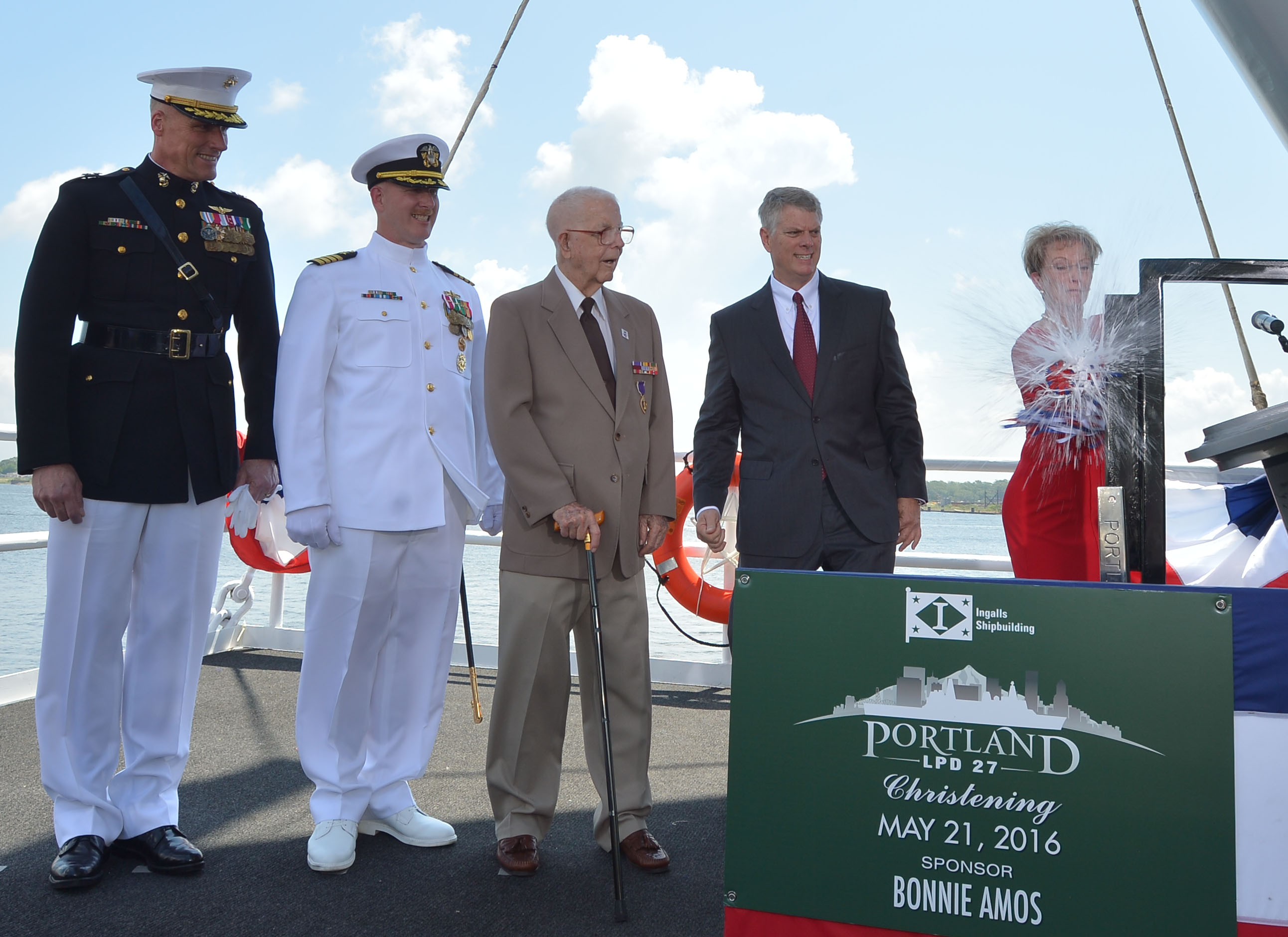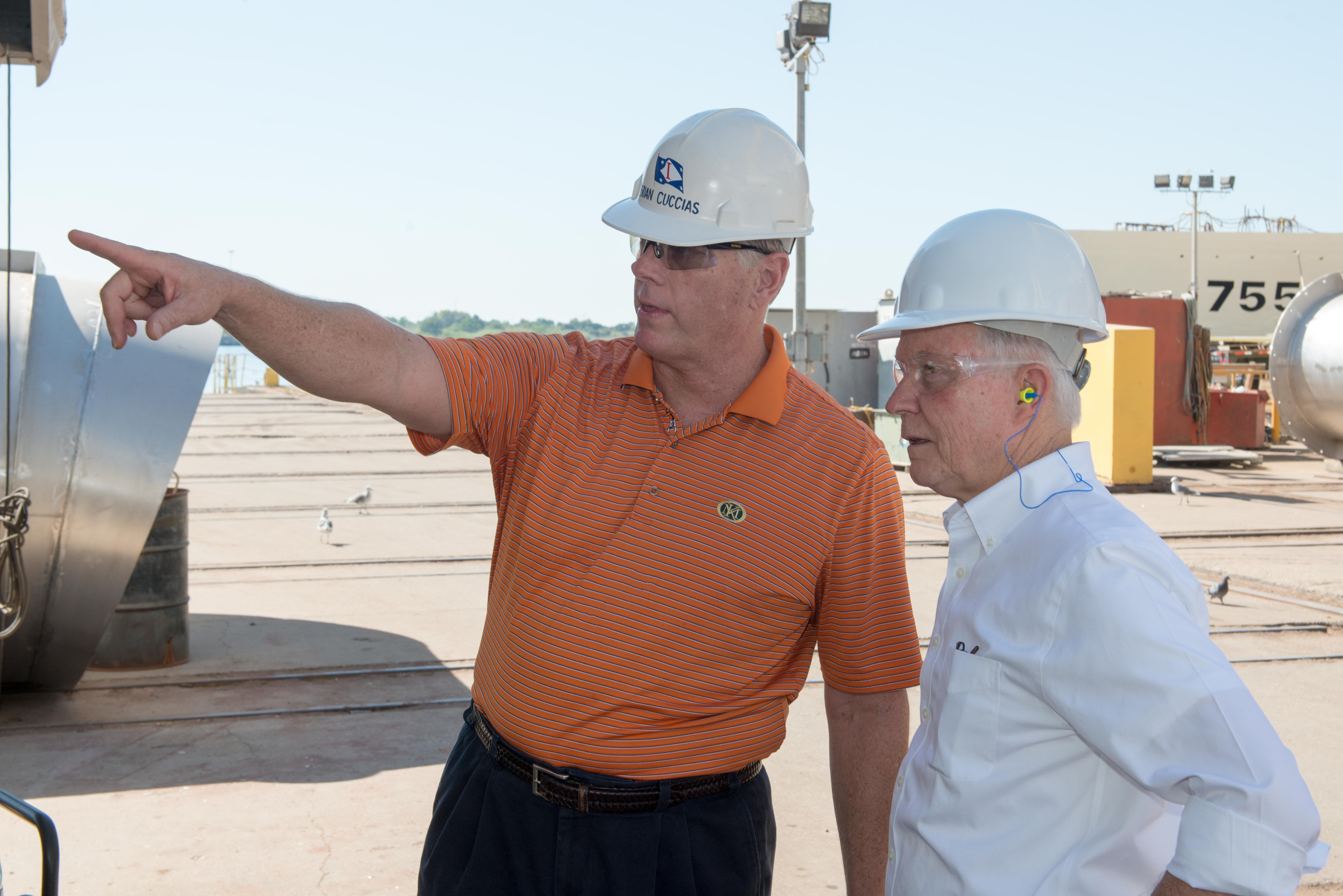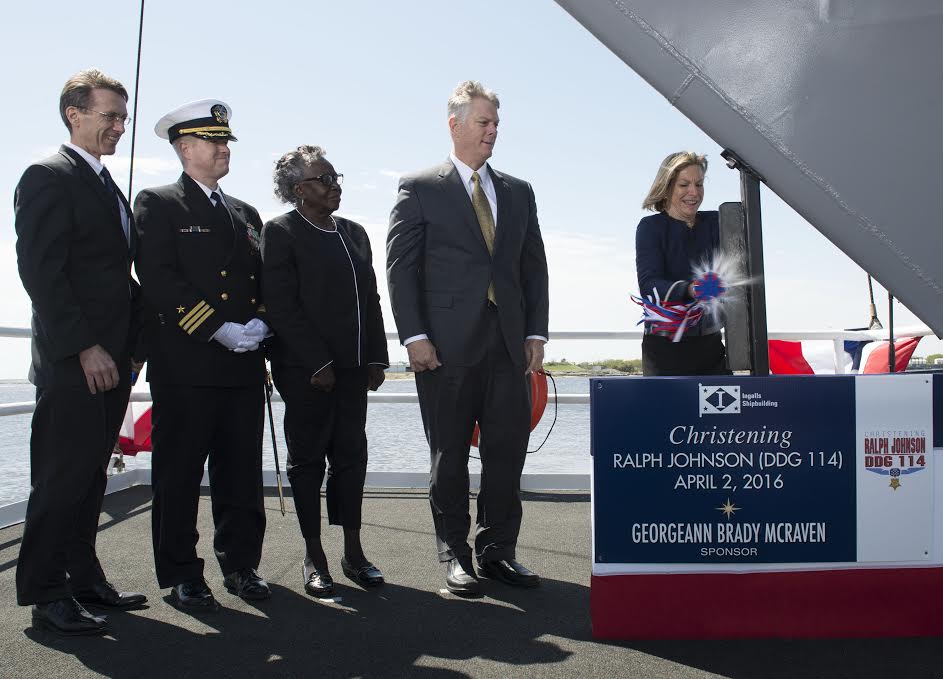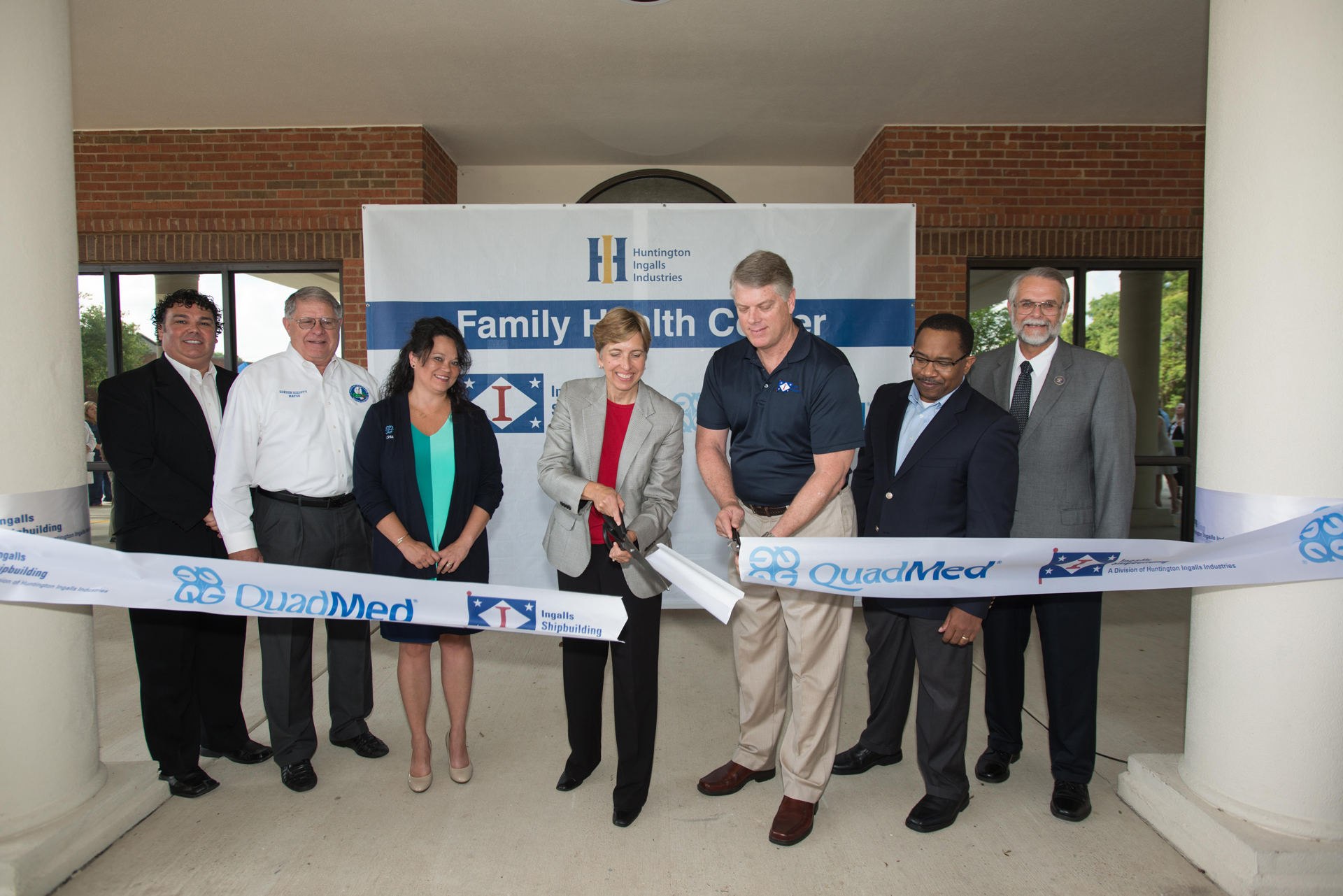
In a precarious time for warship builders – when the Navy predicts a frigate downselect will force one of seven major U.S. warship builders out of business and most of the others depend on just one or two Navy contracts – business at Ingalls Shipbuilding in Mississippi is booming. Ten ships across four ship classes are under construction today, and the yard is looking forward to competing in several upcoming competitions with the Navy and Coast Guard.
Ingalls Shipbuilding President Brian Cuccias sat down with USNI News this month at the Navy League’s Sea-Air-Space Exposition 2016 to talk about business at the yard.
Its San Antonio-class amphibious transport dock (LPD-17) program is nearing the end of serial production – unless Congress moves forward with talk of buying an LPD-29, which would be the 13th ship in the class.
Arleigh Burke-class guided missile destroyer John Finn (DDG-113) is nearing its sea trials and will deliver later this year, the first after a five-year pause in destroyer production. Cuccias said the yard lost a lot of talent and experience during the break in that ship program but has invested in leadership development and worker training to build a quality ship at a competitive price.
The shipyard also has amphibious assault ship Tripoli (LHA-7) at the yard and is building the Coast Guard’s National Security Cutter class, adding to the stability and diversity of the yard’s workload. Though faring well at the moment, Cuccias said the yard is in the midst of a “Shipyard of the Future” capital improvement effort to best set the yard up for success in future competitions.
The following is the May 17 interview, edited for clarity and length.

USNI News: There’s talk in Congress about either accelerating the start of LX(R) or building an LPD-29. How do you view that, especially since LPD-29 would definitely be awarded to you versus LX(R) you’re still competing for? How are you looking at that situation from a material and workforce standpoint?
Brian Cuccias: Let me say that I think we’re doing very well on the LPD program right now. It really is hallmarked by serial production. When you have stable requirements, when you have good ship intervals, you really get a workforce that becomes very efficient in producing the ship. That’s where LPD is right now. So we just delivered LPD-26. LPD-27 (had a christening later that week). Both those ships have done very well. … When you have a hot production line and you have a really experienced workforce, I think it makes all the sense to actually (continue production) – the Marines need the ship, I think they’ve been clear about needing more capable, survivable amphibs. And 28 was a bridge ship, didn’t quite get to the LX(R) so a bridge ship, whatever they choose to call it, behind 28 makes a lot of sense. I think accelerating LX(R) is still a good idea. Accelerating LX(R) and an additional ship from 28 creates a good bridge to keep really a capable workforce employed, engaged and very productive. And I think that is a win all around.
USNI News: What is the status of LPD-28, and when would you need to start making decisions related to whatever ship may come next?
Cuccias: We’ve already had some long-lead authorization on 28, so some of that has been done and some material has been purchased. We still have to finalize the contract, but some long-lead parts (acquisition) has taken place. So LPD-28 is in a good position, and we’re looking forward to making another fine ship. … We’re ready to do LPD-29 long lead right now, if it was 29 or LX(R). One of the discussions on 28, it did fall a little bit behind 27, later than we would ideally like, and so these ship intervals, I don’t want to get into the specific intervals of the ships, but having a follow-on to 28, we just received long lead so we’re within a window from now up through sometime next year for long lead for the following ship.
USNI News: Is your shipyard workforce level right to accommodate a follow-on ship after LPD-28?
Cuccias: The issue in terms of hiring or not is that if you have too large of a gap in the production run, that then impacts, either you have to find other work for those shipbuilders or they have to go home and then you have to rebuild the workforce (later). And when the Arleigh Burke class line was started again, into 113 from 110, there was an efficiency that was lost from the 110, the last ship delivered before 113 was started. And so it’s those efficiencies and teams you have to rebuild and recreate that we believe can be avoided if a follow-on 29 happens and an acceleration of LX(R) – you can maintain those efficiencies and you don’t have to just rebuild your workforce.
USNI News: Ingalls Shipbuilding has pitched several ideas for LPD variants in the past, including hospital ships, submarine tenders, ballistic missile defense ship and recently LPDs with vertical launching system (VLS) tubes. What is the status of talks with the Navy on these variants?
Cuccias: I believe there is some interest in a term called distributed lethality, and so the LPD hull form, I would say it has the lines of the ship that allow for a lot of things to take place without a massive change to the ship itself. You could put a vertical launcher, you could put a bigger aperture, so your sensing side, your offensive and defensive weapons, it can handle it pretty readily and you don’t have to have a clean-sheet design to make that happen. And so we certainly think it’s a good idea. We’re trying to see if there’s a real need and a real interest for that, and if the Navy believes there’s an interest there we’ll try to support it. I believe it’s important that industry helps the Navy, helps with their innovation. We have all the experience with amphibs in the country, we’ve basically done all the amphibs, so we have a huge engineering department and a huge great insight in terms of what can be done, what capabilities can be done. So we think it’s part of our responsibility to go to our customer and say, we think this is a good idea, we think it will serve the country well, serve the Marines, and it may be a capability you’re interested in. .. Do you think it’s a good idea as well?
USNI News: Are any of these ideas gaining any traction?
Cuccias: I think they’re talking about the ideas in terms of buying – I mean we’re nowhere near that stage, but I think there is some interest from different parts of the Navy and so I think I’ll just have to leave it there and see where the Navy goes. With the increasing concern of maybe where Russia’s headed and where China is headed, what does distributed lethality mean to other people? A launcher can easily go on an LPD, a big aperture big radar can easily be put on an LPD. It has the displacement and arrangeable internal volume to handle more cooling, more power, which all are key components to pull that off. We’ll see. We’re getting good engagement, but really right now we’re just talking about it.
USNI News: Would an LPD with VLS tubes also carry Marines, or would it be single-mission like some of the other LPD variant designs Ingalls has proposed in the past?
Cuccias: You can actually have a mission that would serve multiple purposes, it wouldn’t be necessarily single-purpose. So you could have an LPD that would actually have Marine service and after it did the Marine service it could actually be a defensive piece or it could actually be an offensive weapon instead of just waiting for the Marines to return. So you could do multiple purposes on the same platform. … What those applications are and what the need would be, obviously only the customer knows what those assessments would be. But the ship has the capability to do that.

USNI News: What is the status of DDG-113, and with it being the first restart destroyer, how do you think the shipyard handled restarting the program?
Cuccias: I think we actually did an outstanding job in that area, but it was still hard. And there are efficiencies that come trying to rebuild the experience and the talent. Maybe the best way to describe it is, when we were in the heart of Arleigh Burke destroyers before, the team building the ship, part of their role was to develop the shipbuilders for the next platform. And so when you have a platform that runs out, there’s no retraining and redevelopment. So when you have the five-year gap between 110 and 113, the leadership that was there, the leadership in the yard – we basically had to start identifying, who’s going to be the leader in these areas? How do we train them? How do we become more effective? People who have never been on a destroyer, they’re kind of on a T1 (first unit) learning curve on that ship. So it’s that effect rather than, oh they’re hitting T14 or T18 or whatever it is, so that’s really the effect of it. It’s always hard when you have a start, there’s always inefficiency in it, but I actually think we’ve done quite well and the destroyer program is really getting on a real predictable and a good learning (curve).
USNI News: What does the rest of DDG-113’s schedule look like this year?
Cuccias: It will be headed to trials later this year. I think it has some new systems on the ship, but I think it’s a very capable platform and we’re actually very pleased where it is. We’re doing very good on lessons learned from hull to hull, and we’re getting enough ships in line where the same teams that built 113 and 114 are now building the following ships, so we’re getting the hard lessons learned on the following ships.
USNI News: Congress is working on completing the funding for an additional DDG outside the Navy’s original plans. Would you have to add additional manpower or facilities to accommodate an increase in work?
Cuccias: We’re not at capacity at the yard right now. Right now we have four classes of ships being built at the yard, we currently have 10 ships under construction, and we’re doing well across the board. We’re doing well in every class, we’re doing well in every platform in terms of both cost and schedule. … We’re not at our capacity now and we have no problem taking on the additional destroyer work.

USNI News: In addition to building four ship classes you’re also working on capital improvements. What work are you doing to the shipyard?
Cuccias: When we looked at the “Shipyard of the Future,” we looked at it in two aspects. We’re looking at the front end of the business, design tools, build strategies, IT efficiencies, how you move information. … And then you have the brick and mortar side. A lot of times people talk a lot about the brick and mortar side of the Shipyard of the Future, but it also involves a lot more of the front end part of the business, which I think are big enablers as well. From the brick and mortar, we looked at the process flow of the product through the yard. What’s the right build approach, and then what’s the most efficient way to have that build approach come through the yard? Our yard has a lot of open air construction – out in the sun, out in the weather – and it can be a very difficult environment to build in. So we’re improving the covered space where our shipbuilders work. Our drydock that we currently have was built in the 1960s, so part of the plan is actually to bring a new drydock on. One, we just need a new drydock, it’s getting old, but it actually will allow us to transition ships into the water from multiple locations in the yard rather than one place where it is today. So that gets into the product flow point. So it’s all kind of about, how do you make the workers more efficient, how do you make them more effective? Environment is one of them. How do they access their work is another one, so there’s all the enablers that make them all that they can be. And so the Shipyard of the Future involves the layout of the facilities, where the restrooms are. Are there ladders or are there stairs? How do the products move through the yard? How much is in cover or in the sun? It talks about all those aspects.
USNI News: Are these yard improvements driven by pressure from the Navy to keep cost down?
Cuccias: I think it is the responsibility of industry to always be as efficient as you can and not to be complacent. Certainly the tightening budgets – our country needs a capable and survivable warship, and I know that the dollars of old may not be the same available dollars they have today, so I think it is our responsibility to find better ways, more efficient ways, to deliver the capable product at a better value. So we’re always striving on how to do that. One, it’s just smart to do that in the marketplace, but I think it’s patriotic to do it as well.





